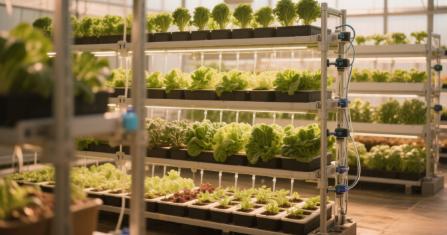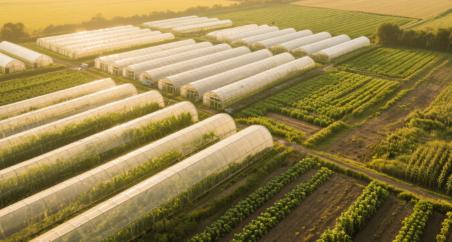The Complete Guide to Climate-Controlled Greenhouses: From Concept to Profitability
The agricultural landscape is evolving fast, with climate-controlled greenhouses becoming a cornerstone for modern, efficient farming. These sophisticated structures allow farmers to regulate temperature, humidity, light, and CO2 levels—creating an ideal environment for growing crops year-round, regardless of external weather conditions.
But what exactly are climate-controlled greenhouses? How do they operate, and what are the steps from setting up such a facility to turning it into a profitable business? This guide walks you through the essentials.
1. What is a Climate-Controlled Greenhouse?
A climate-controlled greenhouse is a sealed or semi-sealed structure equipped with advanced systems to manage environmental factors. Unlike traditional greenhouses that depend heavily on natural conditions, these greenhouses use technology such as heating, ventilation, air conditioning (HVAC), shading, and automated control systems to maintain optimal growth conditions.
This precise control enhances plant growth, reduces pest pressure, and extends growing seasons, leading to higher yields and better quality crops.

2. How to Design and Build Your Climate-Controlled Greenhouse?
Design and construction start with selecting the right location and structure type. The site must offer stable access to utilities like electricity and water and be free from environmental hazards such as flooding or strong winds.
Common greenhouse structures include:
Glass Greenhouses: Offer excellent light transmission but come with higher upfront costs and maintenance.
Polycarbonate Panel Greenhouses: More durable and better insulated than glass, suitable for most climates.
Plastic Film Greenhouses: Cost-effective and flexible but may require more frequent replacement.
Incorporating modular design elements allows future expansions and upgrades. The internal layout should optimize space utilization for planting areas, work zones, storage, and access paths.
3. What Technologies Power Climate Control?
The heart of a climate-controlled greenhouse lies in its technological systems:
Heating and Cooling: Heat pumps, boilers, fans, and wet curtains work together to keep temperatures within the ideal range.
Humidity Management: Dehumidifiers and ventilation systems prevent fungal diseases and promote healthy plant development.
Lighting Control: Supplemental LED lighting extends daylight hours and improves photosynthesis.
CO2 Enrichment: Controlled CO2 levels boost crop growth rates.
Automation: Sensors and computerized controllers monitor and adjust all parameters in real-time, minimizing manual labor.
These systems, combined with smart software platforms, enable remote monitoring and precision farming.
4. Which Crops Thrive in Climate-Controlled Greenhouses?
High-value, delicate crops benefit the most, including:
Berries: Strawberries and blueberries grow faster and produce higher yields.
Leafy Greens: Lettuce, spinach, and kale enjoy consistent quality and year-round supply.
Herbs: Basil, mint, and cilantro respond well to controlled environments.
Specialty Crops: Orchids, edible flowers, and medicinal plants command premium markets.
In regions like Yunnan and Jiangsu, greenhouse-grown peppers and tomatoes have become staples for export markets due to their consistent quality.
5. What Are the Costs and ROI Expectations?
Initial investment costs vary based on size, technology, and crop choice. Typically, expenses cover:
Structure construction (glass, PC panels, or plastic film)
Climate control systems and automation
Irrigation and fertigation infrastructure
Labor and operational setup
For a medium-sized greenhouse (around 5,000 sqm), costs often range from 2 to 5 million RMB (300,000 to 750,000 USD).
Profitability depends on yield, crop pricing, and operational efficiency. For example, a tomato greenhouse producing 180 tons annually at 6 RMB/kg wholesale price could generate over 1 million RMB revenue, with a payback period of 4-6 years.
Choosing high-value crops and optimizing production cycles can further shorten ROI timeframes.

6. How to Operate and Maintain Your Greenhouse for Success?
Continuous monitoring is crucial. Regular calibration of sensors, timely maintenance of HVAC units, and pest management strategies prevent losses.
Integrating data analytics can help detect growth trends, optimize fertilizer use, and forecast market demands.
Training staff on system operations and emergency protocols ensures smooth functioning.
Collaboration with experienced companies like Chengfei Greenhouse can provide technical support and help implement best practices.
7. What Challenges Should Investors Be Aware Of?
Potential hurdles include:
High upfront capital requirements
Need for skilled technical workforce
Market fluctuations impacting crop prices
Pest and disease outbreaks despite controlled environment
Mitigating these risks requires thorough planning, diversified crop selection, and establishing reliable sales channels before production starts.
8. What Does the Future Hold for Climate-Controlled Greenhouses?
Emerging trends include:
Solar-powered climate systems reducing energy costs
Integration of AI and machine learning for predictive growing models
Vertical farming integration within greenhouses for space maximization
Carbon-neutral and eco-friendly certification to meet export standards
These advances promise greater sustainability and profitability.
Investing in climate-controlled greenhouses represents a strategic step toward the future of agriculture—balancing technological innovation with economic viability to meet rising global food demands.
Welcome to have a further discussion with us.
Email:Lark@cfgreenhouse.com
Phone:+86 19130604657
Post time: Aug-01-2025







 Click to Chat
Click to Chat